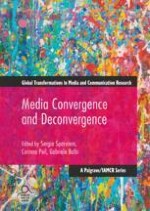2017 | OriginalPaper | Chapter
4. Blurred Lines, Distinct Forces: The Evolving Practices of Italian TV Audiences in a Convergent Scenario
Authors : Luca Barra, Massimo Scaglioni
Published in: Media Convergence and Deconvergence
Publisher: Springer International Publishing
Activate our intelligent search to find suitable subject content or patents.
Select sections of text to find matching patents with Artificial Intelligence. powered by
Select sections of text to find additional relevant content using AI-assisted search. powered by
